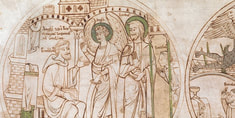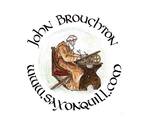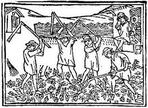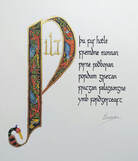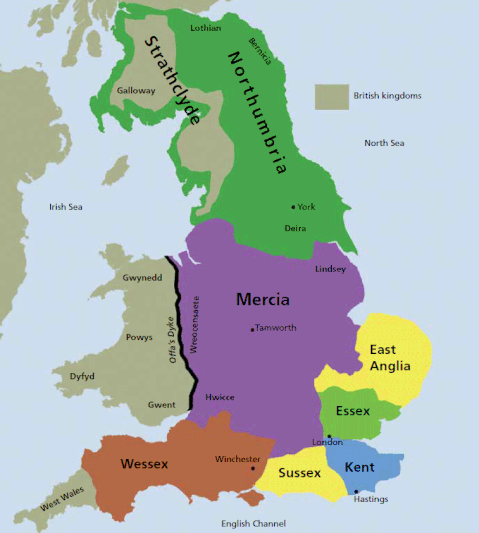 At school they taught us that Anglo-Saxon began in 410 when the Romans definitively abandoned Britannia to defend Rome against Alaric. Instead at university, they chose 383AD presumably because the imperial usurper, Magnus Maximus raised the standard of revolt at Segontium (Caernarfon) in north Wales, and crossed the English Channel.Maximus held much of the western empire, and fought a successful campaign against the Picts and the Scots around 384. His continental exploits required troops from Britain, and it appears that forts at Chester and elsewhere were abandoned in this period, triggering raids and settlement in north Wales by the Irish. Until the late twentieth century, historians drew on the writings of Gildas and Bede. Gildas and other sources were used by Bede in his Historia ecclesiastica gentis Anglorum, written around 731.Bede gave a precise date, 449AD, for the first arrival of the Anglo-Saxons and he said they came from three tribes: the Angles, Saxons and Jutes, who themselves came from different parts of Germany and Denmark – the Angles were from Angeln, which is a small district in northern Germany; the Saxons were from what is now Lower Saxony, also in northern Germany; and the Jutes were from Jutland, now part of Denmark. According to Bede the Angles settled in East Anglia, the Saxons in southern England, and the Jutes in Kent and the Isle of Wight. I do not believe any of the dates 383, 410 and 449 are credible. The truth is that much earlier Saxon legionnaires came to Britain, retired from the legion, married Britons, cleared land and tilled it, settling and introducing their language, Old English, to the Britons. The construction of roman forts, the Saxon Shore forts provide further evidence in the third century that Saxon piracy was rife along the south and east coasts. Other archaeological evidence indicates a Saxon presence in England as early as the third century. Gildas used the correct late Roman term for the Saxons, foederati, people who came to Britain under a well-used treaty system. This kind of treaty had been used elsewhere to bring people into the Roman Empire to move along the roads or rivers and work alongside the army. Gildas called them Saxons, which was probably the common British term for the settlers. Hence, my current work-in-progress, a novel beginning in 286AD and provisionally entitled The Saxon Shore. I hope to finish it before the Spring, as I ama bout to start Chapter 9, there’s a way to go yet. After the turbulent end to the roman period in Britain, matters become clearer. The fifth-century settlement is still obscure, but events become clearer with the Anglo-Saxon kingdoms, c. 650-800AD I now wish to list my published Anglo-Saxon novels in the following heptarchy (7 kingdoms) context (See map): 1. Kent, settled by the Jutes. Ethelbert of Kent was the first Anglo-Saxon king to be converted to Christianity, by St Augustine around 595 AD. 2. Mercia, whose best-known ruler, Offa, built Offa's Dyke along the border between Wales and England. This large kingdom stretched over the Midlands. 3. Northumbria, where the monk Bede (c. 670-735) lived and wrote his Ecclesiastical History of Britain. 4. East Anglia, made up of Angles: the North Folk (living in modern Norfolk) and the South Folk (living in Suffolk). The Sutton Hoo ship burial was found in East Anglia (see below). 5. Essex (East Saxons). Here the famous Battle of Maldon was fought against the Vikings in 991. 6. Sussex: the South Saxons settled here. 7. Wessex (West Saxons), later the kingdom of King Alfred, the only English king ever to have been called ‘the Great', and his equally impressive grandson, Athelstan, the first who could truly call himself ‘King of the English'. Here are my novels with dates and kingdoms specified (more or less in order of publication)
When did Anglo-Saxon England end? Every schoolchild learns 1066 with the Norman Conquest. But is that true? Depends. Certainly, almost all the Saxon aristocracy perished in that year and the Normans seized their lands, but rural life continued unchanged. You have to evaluate the millions of peasants against the hundreds of Norman aristocrats. Sadly, the splendid Anglo-Saxon culture was destroyed. Finally, King Harold’s daughter married the Prince of Kiev – that might be a novel in the making! Thank you for reading.  Get a free eBook!Join my newsletter & receive a free digital copy of Heaven in a Wildflower, book 1 of my St. Cuthbert Trilogy, as well as monthly news, insights, historical facts, & exclusive content delivered straight to your inbox! Thank you!You have successfully joined my mailing list!
0 Comments
Leave a Reply. |
To buy your copy of Rhodri's Furies click the link below:
https://www.amazon.co.uk/Rhodris-Furies-Ninth-century-Resistance-incursions-ebook/dp/B0BPX9C2D3/ |
